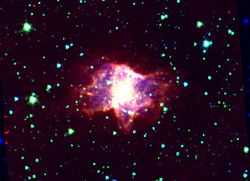NGC 6072
From Wikipedia, the free encyclopedia
| NGC 6072 | |
|---|---|
 A Spitzer Space Telescope image of NGC 6072 | |
| Observation data (Epoch J2000.0) | |
| Right ascension | 16h 12m 58.2s[1] |
| Declination | −36° 13′ 48.0″[1] |
| Apparent magnitude (V) | 14[2] |
| Apparent dimensions (V) | 1.2'[2] |
| Constellation | Scorpius |
| Physical characteristics | |
| Other designations | PK 342+10 1 , PN My 93, HD 2-148, PN Sa 2-134, PN ARO 500, PN G342.1+10.8, IRAS F16097-3606, PN VV' 131, SCM 107, PN VV 77, |
| See also: Planetary nebula, Lists of nebulae | |
NGC 6072 is a type I nebulae in the constellation Scorpius. It has a dynamical age of 104 years. Its circumstellar envelope is likely to be rich in Carbon as it has very strong CN (Cyanide) spectral lines. CN spectral lines are generally not detected in Oxygen rich AGB (Asymptotic giant branch) circumstellar envelopes. NGC 6072 also shows H2 (Hydrogen) emission and intense CO (Carbon Monoxide) emission which has been mapped displaying bipolarity and some gas at high velocity. The evolution of this planetary nebulae is likely to be dominated by photodissociation and ion/radical molecular reactions. Shock chemistry is also likely to be important.
References
- ↑ 1.0 1.1 "NASA/IPAC EXTRAGALACTIC DATABASE". Results for NGC 6072. Retrieved 2009-03-16.
- ↑ 2.0 2.1 "Students for the Exploration and Development of Space". Results for NGC 6072. Retrieved 2009-03-21.
- Astron. Astrophys. 266, 420-428 (1992)
This article is issued from Wikipedia. The text is available under the Creative Commons Attribution/Share Alike; additional terms may apply for the media files.